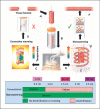New Approaches to Cryopreservation of Cells, Tissues, and Organs
- PMID: 31244588
- PMCID: PMC6558330
- DOI: 10.1159/000499453
New Approaches to Cryopreservation of Cells, Tissues, and Organs
Abstract
In this concept article, we outline a variety of new approaches that have been conceived to address some of the remaining challenges for developing improved methods of biopreservation. This recognizes a true renaissance and variety of complimentary, high-potential approaches leveraging inspiration by nature, nanotechnology, the thermodynamics of pressure, and several other key fields. Development of an organ and tissue supply chain that can meet the healthcare demands of the 21st century means overcoming twin challenges of (1) having enough of these lifesaving resources and (2) having the means to store and transport them for a variety of applications. Each has distinct but overlapping logistical limitations affecting transplantation, regenerative medicine, and drug discovery, with challenges shared among major areas of biomedicine including tissue engineering, trauma care, transfusion medicine, and biomedical research. There are several approaches to biopreservation, the optimum choice of which is dictated by the nature and complexity of the tissue and the required length of storage. Short-term hypothermic storage at temperatures a few degrees above the freezing point has provided the basis for nearly all methods of preserving tissues and solid organs that, to date, have proved refractory to cryopreservation techniques successfully developed for single-cell systems. In essence, these short-term techniques have been based on designing solutions for cellular protection against the effects of warm and cold ischemia and basically rely upon the protective effects of reduced temperatures brought about by Arrhenius kinetics of chemical reactions. However, further optimization of such preservation strategies is now seen to be restricted. Long-term preservation calls for much lower temperatures and requires the tissue to withstand the rigors of heat and mass transfer during protocols designed to optimize cooling and warming in the presence of cryoprotective agents. It is now accepted that with current methods of cryopreservation, uncontrolled ice formation in structured tissues and organs at subzero temperatures is the single most critical factor that severely restricts the extent to which tissues can survive procedures involving freezing and thawing. In recent years, this major problem has been effectively circumvented in some tissues by using ice-free cryopreservation techniques based upon vitrification. Nevertheless, despite these promising advances there remain several recognized hurdles to be overcome before deep-subzero cryopreservation, either by classic freezing and thawing or by vitrification, can provide the much-needed means for biobanking complex tissues and organs for extended periods of weeks, months, or even years. In many cases, the approaches outlined here, including new underexplored paradigms of high-subzero preservation, are novel and inspired by mechanisms of freeze tolerance, or freeze avoidance, in nature. Others apply new bioengineering techniques such as nanotechnology, isochoric pressure preservation, and non-Newtonian fluids to circumvent currently intractable problems in cryopreservation.
Keywords: Cryopreservation; Isochoric cryopreservation; Liquidus tracking; Nanowarming; Non-Newtonian cryoprotection; Vitrification.
Figures







References
-
- Lewis JK, Bischof JC, Braslavsky I, Brockbank KG, Fahy GM, Fuller BJ, et al. The Grand Challenges of Organ Banking: proceedings from the first global summit on complex tissue cryopreservation. Cryobiology. 2016 Apr;72((2)):169–82. - PubMed
-
- Ravikumar R, Leuvenink H, Friend PJ. Normothermic liver preservation: a new paradigm? Transpl Int. 2015 Jun;28((6)):690–9. - PubMed
-
- Hosgood SA, van Heurn E, Nicholson ML. Normothermic machine perfusion of the kidney: better conditioning and repair? Transpl Int. 2015 Jun;28((6)):657–64. - PubMed
Publication types
Grants and funding
LinkOut - more resources
Full Text Sources
Other Literature Sources

